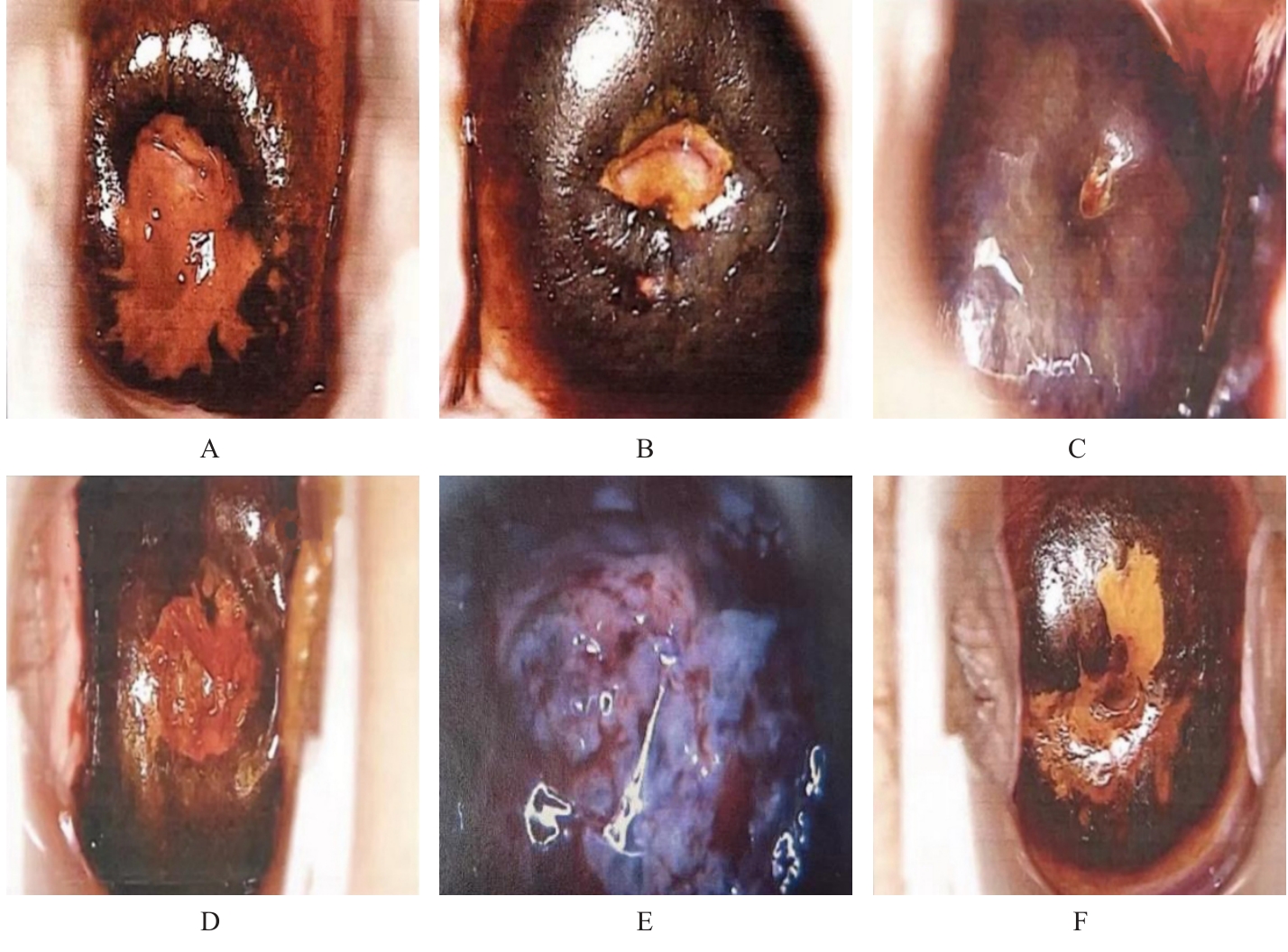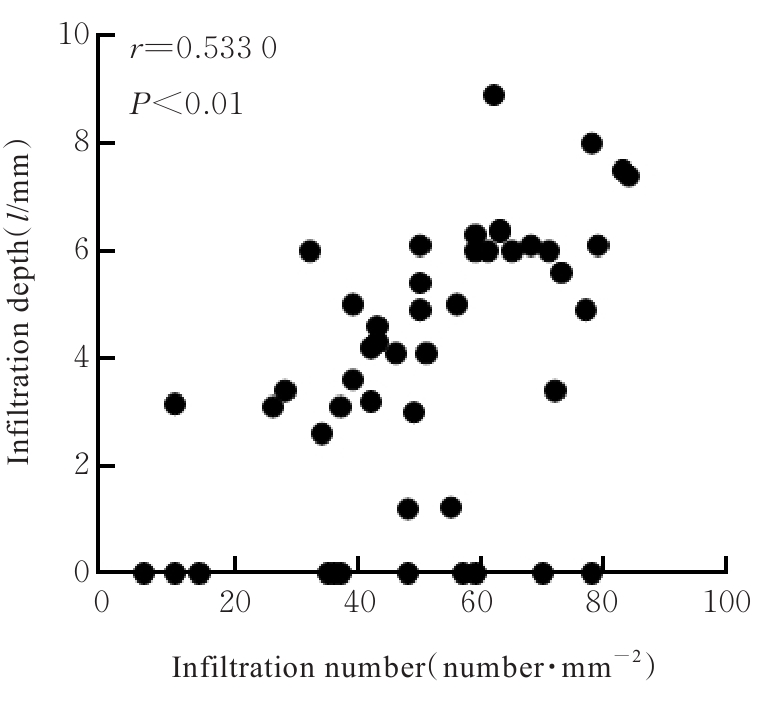吉林大学学报(医学版) ›› 2024, Vol. 50 ›› Issue (6): 1691-1702.doi: 10.13481/j.1671-587X.20240623
• 临床研究 • 上一篇
宫颈病变和宫颈癌组织中嗜酸性粒细胞浸润及其临床意义
鲁艳艳1,2,许翔博1,3,吴亚梅2,刘雨齐1,王涵1,杨丽娟1,王振江1,肖梓屾1,刘艳波1( )
)
- 1.北华大学基础医学院病理生理学教研室,吉林 吉林 132013
2.吉林省长春市妇产医院病理科,吉林 长春 130028
3.吉林省吉林市人民医院妇产科,吉林 吉林 132011
Eosinophil infiltration in cervical lesion and cervical cancer tissues and their clinical significances
Yanyan LU1,2,Xiangbo XU1,3,Yamei WU2,Yuqi LIU1,Han WANG1,Lijuan YANG1,Zhenjiang WANG1,Zishen XIAO1,Yanbo LIU1( )
)
- 1.Department of Pathophysiology,School of Basic Medical Sciences,Beihua University,Jilin 132013,China
2.Department of Pathology,Gynaecology and Obstetrics Hospital,Changchun City,Jilin Province,Changchun 130028,China
3.Department of Gynaecology and Obstetrics,People’s Hospital,Jilin City,Jilin Province,Jilin 132011,China
摘要:
目的 探讨嗜酸性粒细胞(EOS)在宫颈组织中的浸润差异及其与宫颈相关疾病之间的关系,阐明EOS对宫颈上皮不典型增生(CIN)和宫颈癌发生发展的影响。 方法 收集256例宫颈疾病患者的临床资料,根据其发病情况分为宫颈癌组(n=46,其中宫颈鳞状细胞癌26例、宫颈腺癌15例和宫颈腺鳞癌5例)、慢性宫颈炎组(n=50)、CINⅠ期组(n=50)、CINⅡ期组(n=50)、CINⅢ期组(n=30)和正常组(癌旁正常宫颈组织,n=30)。阴道镜观察各组患者宫颈组织形态表现,薄层液基细胞学测试(TCT)法观察各组患者宫颈脱落细胞形态表现,杂交捕获-化学发光法检测各组患者宫颈组织人乳头瘤病毒(HPV)感染情况,HE染色观察各组患者宫颈组织病理形态表现,刚果红染色检测各组患者宫颈组织中EOS浸润数,Pearson相关性分析EOS浸润数与宫颈癌恶性程度的相关性。 结果 正常组患者宫颈表面光滑,呈粉红色,毛细血管均匀分布;慢性宫颈炎组患者宫颈表面呈红色炎性改变,部分伴有纳氏囊肿形成,可见不同程度的糜烂和溃疡等;CINⅠ期、CINⅡ期和CINⅢ期组患者宫颈可见上皮溃疡、增厚和形态不规则,细镶嵌及点状血管明显;宫颈癌组患者宫颈表面隆起,可见新生肿物及坏死性溃疡,质脆易出血。醋酸染色后,正常组患者宫颈无明显改变;慢性宫颈炎组患者宫颈呈少量白色改变,持续时间较短;CINⅠ期、CINⅡ期和CINⅢ期组患者宫颈薄醋白上皮不规则、呈地图样边界,其中CINⅠ期组患者宫颈部分组织呈醋白反应,CINⅡ期组患者宫颈出现明显醋白反应,CINⅢ期组患者宫颈醋白反应非常明显,面积较大,且持续时间较长;宫颈癌组患者宫颈醋白反应明显,白色上皮厚,持续时间久,轮廓硬直,边界清晰。正常组患者宫颈碘染色后呈棕褐色,着色均匀;慢性宫颈炎组患者宫颈炎性病变区着色差;CINⅠ期组患者宫颈上皮化生区碘着色不明显;CINⅢ期组患者宫颈病变区着色差,转化区周围面积较大;宫颈癌组患者宫颈表面不规则,呈菜花样生长,碘染色后不着色,呈现为橘黄或芥末黄色。TCT法观察,正常组患者宫颈脱落细胞中无异型性细胞,炎症细胞浸润少;慢性宫颈炎组患者宫颈脱落细胞中可见大量的中性粒细胞和EOS等炎症细胞,无异型性细胞;CINⅠ期和CINⅡ期组患者宫颈脱落细胞中可见双核异型性细胞,核质比较高,细胞核较深染,周围见空晕;CINⅢ期组患者脱落细胞中可见较多异型性细胞,核质比较高,核膜不规则;宫颈癌组患者宫颈脱落细胞中可见大而显著的核仁,聚集成片,合胞体样改变明显;与正常组比较,CINⅠ期组、CINⅡ期组、CINⅢ期组和宫颈癌组患者宫颈脱落细胞异型性均明显增加。杂交捕获-化学发光法检测,与正常组和慢性宫颈炎组比较,CINⅠ期、CINⅡ期和CINⅢ期组患者HPV感染数和TCT异型性细胞数均明显增加(P<0.05);与CINⅠ期、CINⅡ期和CINⅢ期组比较,宫颈癌组患者HPV感染数和TCT异型性细胞数均明显增加(P<0.05)。HE染色观察,正常组宫颈组织细胞形态正常,结构清晰,可见中性粒细胞、单核细胞、巨噬细胞、EOS和淋巴细胞等炎症细胞浸润;慢性宫颈炎组患者炎症细胞浸润增加;CIN组患者宫颈细胞核核仁稍大,可见异型性细胞,炎症细胞主要分布于异型性细胞周围;宫颈癌组患者宫颈细胞核仁大而深染,细胞异型性明显,癌细胞周围炎症细胞浸润增加。与正常组比较,慢性宫颈炎组患者宫颈组织中炎症细胞数和EOS浸润数均明显增加(P<0.05),CIN组患者炎症细胞数和EOS浸润数均明显增加(P<0.05);与慢性宫颈炎组比较,CIN组患者炎症细胞数和EOS浸润数均明显减少(P<0.05);与慢性宫颈炎组和CIN组比较,宫颈癌组患者炎症细胞数和EOS浸润数均明显增加(P<0.05)。宫颈癌组织中EOS主要分布于癌巢周围,与CINⅠ期组比较,CINⅡ期组和CINⅢ期组患者宫颈组织中EOS浸润数均明显增加(P<0.05);与CINⅡ期组比较,CINⅢ期组患者宫颈组织中EOS浸润数明显增加(P<0.05)。肿瘤恶性程度越高,EOS浸润越多,EOS浸润数与宫颈癌浸润深度呈正相关关系(r=0.533 0,P<0.01)。 结论 HPV感染和EOS浸润具有促进宫颈癌癌前病变及宫颈癌发生发展的作用。
中图分类号:
- R737.33
















